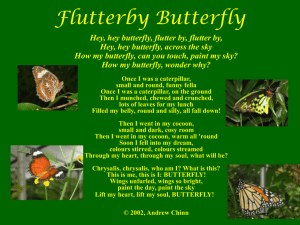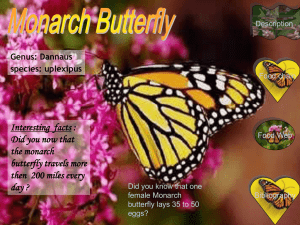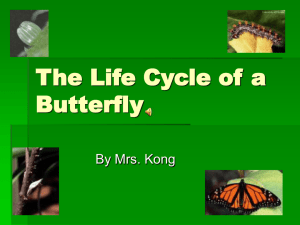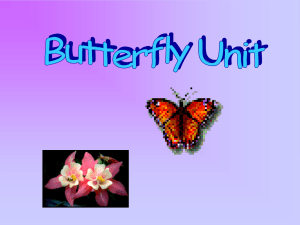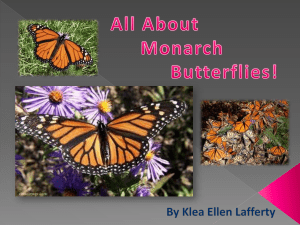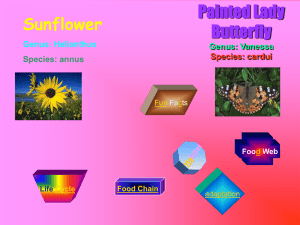Oh, Miss Jones
advertisement
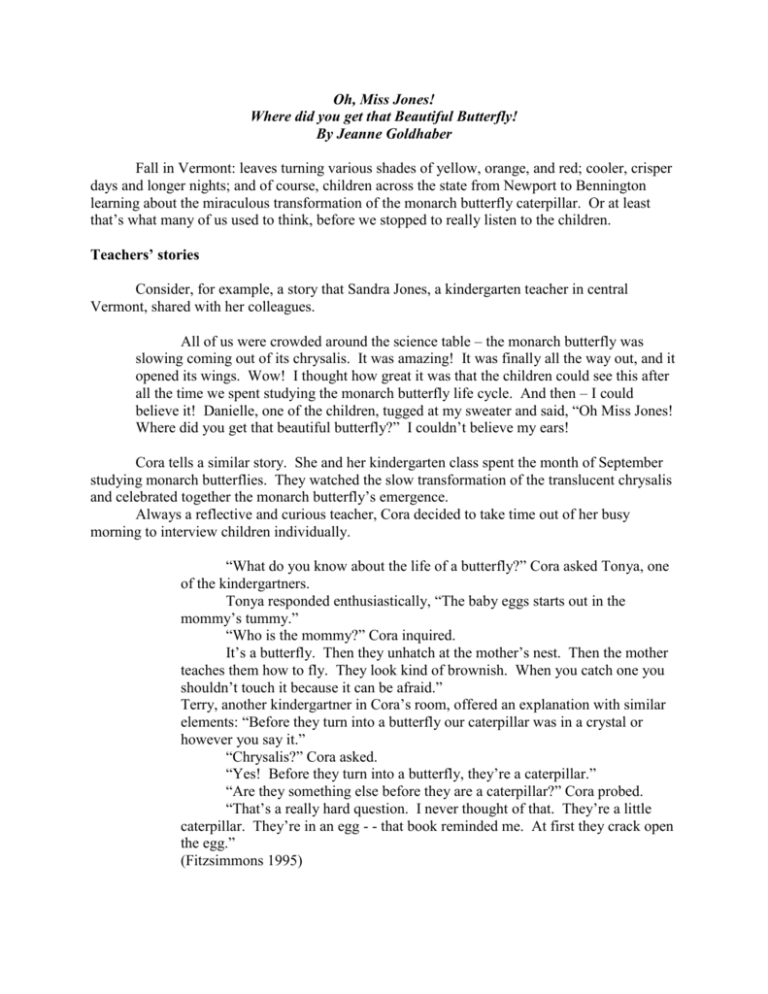
Oh, Miss Jones! Where did you get that Beautiful Butterfly! By Jeanne Goldhaber Fall in Vermont: leaves turning various shades of yellow, orange, and red; cooler, crisper days and longer nights; and of course, children across the state from Newport to Bennington learning about the miraculous transformation of the monarch butterfly caterpillar. Or at least that’s what many of us used to think, before we stopped to really listen to the children. Teachers’ stories Consider, for example, a story that Sandra Jones, a kindergarten teacher in central Vermont, shared with her colleagues. All of us were crowded around the science table – the monarch butterfly was slowing coming out of its chrysalis. It was amazing! It was finally all the way out, and it opened its wings. Wow! I thought how great it was that the children could see this after all the time we spent studying the monarch butterfly life cycle. And then – I could believe it! Danielle, one of the children, tugged at my sweater and said, “Oh Miss Jones! Where did you get that beautiful butterfly?” I couldn’t believe my ears! Cora tells a similar story. She and her kindergarten class spent the month of September studying monarch butterflies. They watched the slow transformation of the translucent chrysalis and celebrated together the monarch butterfly’s emergence. Always a reflective and curious teacher, Cora decided to take time out of her busy morning to interview children individually. “What do you know about the life of a butterfly?” Cora asked Tonya, one of the kindergartners. Tonya responded enthusiastically, “The baby eggs starts out in the mommy’s tummy.” “Who is the mommy?” Cora inquired. It’s a butterfly. Then they unhatch at the mother’s nest. Then the mother teaches them how to fly. They look kind of brownish. When you catch one you shouldn’t touch it because it can be afraid.” Terry, another kindergartner in Cora’s room, offered an explanation with similar elements: “Before they turn into a butterfly our caterpillar was in a crystal or however you say it.” “Chrysalis?” Cora asked. “Yes! Before they turn into a butterfly, they’re a caterpillar.” “Are they something else before they are a caterpillar?” Cora probed. “That’s a really hard question. I never thought of that. They’re a little caterpillar. They’re in an egg - - that book reminded me. At first they crack open the egg.” (Fitzsimmons 1995) I too have had an experience similar to Sandra’s and Cora’s. This fall, while visiting a kindergarten classroom, I noticed Patrick sitting in front of an aquarium that held several chrysalises hanging from the screened top. On the table next to the aquarium were blank sheets of paper for the children to record their observations. As I drew the shape of a chrysalis on one of the sheets, I asked Patrick if he would draw what was happening inside it. “Here’s the caterpillar inside the chrysalis,” he explained as he drew a caterpillarlike form inside my chrysalis. “Then here’s the butterfly” (he drew a small butterfly) “and he crawls into the chrysalis and then he comes out!” How can these stories be true? The children had observed the monarch butterfly in its various stages of transformation; they’d listen to books, discuss butterfly life-cycle charts, represented its stages of development through various media. How can we plain their answers in the face of these experiences? One could argue that the children’s confusion was the exception to their classmates’ understanding of the monarch butterfly’s life cycle. This is possible, of course, but I suspect that the opposite is closer to the truth. I suspect that many if not most of the children would respond to questions such as those put forth by Cora with her own unique versions of how the butterfly came to be. Moreover, I do not view their answers as indicators of the teachers’ failure to teach or of inappropriate curriculum, but rather as intriguing evidence of the nature of learning. By examining their answers, we may come away with both a better understanding of what particular children think as well as renewed appreciation of how children in general process information and construct knowledge. Such an understanding can only result in more sensitive and developmentally appropriate teaching practices. Tonya and Terry: The act of assimilation Cora is very confident that she never discussed the monarch butterfly life cycle in terms of “unhatching at the mother’s nest” or “cracking open the egg,” yet both Tonya and Terry explained the monarch butterfly transformation in terms that reflect elements of a bird’s life cycle. The fact that both butterflies and birds fly may explain why; when confronted with the challenge of explaining the relatively novel monarch butterfly life cycle, both girls drew largely from their seemingly well-established schema of how baby birds hatch from eggs and learn to fly. Assimilating new information, like the monarch butterfly life cycle, into well established schemata, like the life cycle of a bird is an adaptive intellectual act (Piaget 1952; Wadsworth 1996). While Tonya and Terry’s explanations do not describe the monarch butterfly’s life cycle as we know it, they do suggest that both children engaged in very significant thinking! Patrick and Danielle: The role of inference Patrick and Danielle’s theories are in some ways more difficult to explain. Despite the high level of attention the transformation received in both classrooms, they saw the butterflies as essentially unrelated to the chrysalises they had been observing. To the adult thinker, their explanations are practically nonsensical. How can they not know that the caterpillar evolved into the butterfly? They observed the chrysalis every day. They listed to the books about monarch butterflies and talked about the illustrations in the life- cycle charts posted over the aquarium. Danielle was even there at the very moment the butterfly emerged from its chrysalis! Weren’t they looking? Weren’t they listening? The answer is yes, they were. But what they were not doing was equally important and much more cognitively challenging. To genuinely understand the slow but largely invisible transformation of the monarch butterfly, one must rely heavily on inference (Forman & Kuschner 1983). Adults are often unaware of the extent to which inference is involved in their understanding of the change. For example, a red ball rolls under the sofa, is out of sight for three seconds, and then reappears. How do we know that the red ball we saw roll under the sofa is the same red ball that came out seconds later? In fact, we don’t actually know, but rather we infer that we are seeing the same ball in both sightings. We make this inference confidently, based on years of experience in a world in which objects disappear and reappear, maintaining their identity even when we lose sight of them. Moreover, our ability to imagine or represent the path of the ball as it travels under the sofa supports our ability to infer that both sightings involve the same ball. Like adults, most four-, five-, and six-year-olds recognize the red ball that reappears several seconds later as the same ball that rolled under the sofa. Indeed, like adults, they would most certainly express surprise if instead of a red ball, a blue one were to appear. But the problem of the disappearing ball is a relatively simple one: the ball is a very familiar, thoroughly explored object; the ball’s appearance does not change from the first to the second sighting; little time elapses between its disappearance and reappearance; and experiences similar to the disappearing/reappearing ball are a part of everyday life. Compare the caterpillar’s transformation to that of the ball. The caterpillar is a relatively unexplored object; that is, what children know of caterpillars is primarily based on limited observation and what others have told them either directly or indirectly through books, films, and other media. The monarch butterfly caterpillar transformation is also a unique one, with few similar events available for comparison. Within the translucent wrap of the chrysalis, the metamorphosis takes as many as 14 days, during which time the caterpillar’s appearance undergoes several dramatic changes. When the caterpillar finally does emerge as a monarch butterfly, its appearance is completely different in form, color and even mode of locomotion. Upon reflection, perhaps the question is not why Patrick and Danielle do recognize the nature of the relationship between the caterpillar and butterfly, but instead, why they should! Clearly, their ability to represent or imagine the caterpillar’s transformation along a continuum of change is challenged by the very unique nature of the monarch caterpillar metamorphosis. Nor is confusion such as Tonya, Terry, Patrick, and Danielle’s necessarily limited to the monarch butterfly’s life cycle. Indeed, children are constantly confronted with experiences (both teacher initiated and spontaneous) that require them to draw inferences about the relationships between actions or events. For example, a kindergartner who was busily burying “dinosaur fossils” all the sand table predicted that “when all the people are gone, then the dinosaurs will come back.” It makes perfect sense, from the child’s point of view, that dinosaurs and people are mutually exclusive; that is, he understands that (a) there were no people when there were dinosaurs, and (b) there are currently people but no dinosaurs. Consequently, he infers that if the world were to be once again uninhabited by humans, then dinosaurs would return! Do these anecdotes mean here is no place for monarch caterpillars or dinosaur fossils in the kindergarten curriculum? Or that similarly complex questions involving processes of change or transformation should not be investigated? Most decidedly not, for these are the very experiences that have the greatest potential to promote meaningful learning. What these anecdotes do mean, however, is that teachers must go beyond accepting children’s recitations of “facts as presented” as authentic reflections of their learning to a more active and genuine probing of their understanding about the transformation under investigation. Does this mean that we shouldn’t include it (whatever it is) in our curriculum? Going beyond the facts to understanding In asking Tonya and Terry to tell her what they knew about the life of a butterfly, Cora discovered the rich and often secret terrain of children’s worlds. Mother butterflies teach their babies to fly and you need to be careful, because the babies are afraid if you touch them! If Cora hadn’t asked her question, she would never have known how mentally active these two children were in their efforts to understand the complexities of life. Patrick’s version of the caterpillar’s transformation also would have remained hidden if he hadn’t been asked to draw what was happening inside the chrysalis. And while Danielle’s shock at the appearance of “that beautiful butterfly” was unelicited, her teacher stopped to list, record and ponder this little girl’s surprised response to the butterfly’s emergence from its chrysalis. These examples offer simple yet highly effect strategies for probing children’s understanding of their social and physical worlds. The use of open-ended questions that begin with phrases such as “Tell me what you know about…” “How do you think it happened that…,” and “Why do you think that…” offer children the opportunity to share what they really think rather than what they think you want to hear. Asking children to represent what they know through a variety of media can be another effective strategy. The breathtaking exhibit The Hundred Languages of Children (Malaguzzi 1987), preschool-age children’s graphic representations from Reggio Emilia, Italy, provides compelling evidence of children’s capacity to express their ideas and theories through drawing, painting, and sculpting when provided a rich and supportive environment (Forman 1994; Edwards, Gandini, & Forman 1995). The seemingly simple practice of listening, recording, and reflecting is often the best way to begin learning about children’s thinking. The commitment to take 20 minutes every day to watch and listen as children try to make the balance scale stay level or build a time machine to pass through the “near future, not the far future” is clearly a significant one. Writing down what you see and hear is even greater expenditure of time and effort. And finally, finding a moment to reflect on what you recorded may seem like the ultimate teacher extravagance. However, this practice is critical and the payoff is manifold. By listening, teachers learn to trust and respect children’s tireless efforts to make sense of their world. By recording, teachers document the all-too-often hidden intellectual activity of their classroom. By reflecting, teachers assess what children genuinely know and are better able to plan experiences that reflect the children’s authentic knowledge base. Interviewing children informally using open-ended questions, asking children to draw or in some other way represent what they know, and committing time to the practice of listening, recording, and reflecting are three strategies that can significantly influence the climate and content of a classroom. As children become aware of their teacher’s interest in what they think, they become more willing to share their discoveries and theories throughout the day. The classroom becomes a laboratory where ideas are tested and discussed and where teachers savor those moments when they can really listen to the children. Like fall, winter is very dramatic season in Vermont. The trees are bare, the days are cold, the nights are colder, and children are learning about – yes, that’s right, tell me what you know about snow. References: 1. Edwards, C., L. Gandini, & G. Forman. 1995. The hundred languages of children: The Reggio Emilia approach to early childhood education. Norwood, NJ: Ablex. 2. Fitzsimmons, P. 1995. Kindergarten conversations: Butterflies, crystals, and babies. In connections: Newsletter of the Vermont Association for the Education of Young Children (Fall). Available from VAEYS, P.O. Box 5656, Burlington, VT 05402-5656. 3. Forman, G. 1994. Different Media, different languages. In Reflections on the Reggio Emilia approach, eds. L. Katz & B. Cesarone, 41-53. Urbana, IL: ERIC Clearinghouse on Elementary and Early Childhood Education. 4. Forman, G., & D. Kuschner. 1983. The child’s construction of knowledge: Piaget for teaching children. Washington, CD: NAEYC. 5. Malaguzzi, L. 1987. The hundred languages of children. Catalog, Reggio Emilia, Italy: Department of Early Education, Region of Emilia Romagna. 6. Piaget, J. 1954. The origins of intelligence in children. New York: W.W. Norton. 7. Wadsworth, B. 1996. Piaget’s theory of cognitive and affective development: Foundations of constructivism. 5th ed. New York: Longman. Editor’s Note: I have a story like this, too. A two-and-a-half-year-old grandson is watching one of my all-time favorite videos, Bo Peep’s bugs Don’t Bug Us. This bug-lover watches absolutely captivated, as real spiders, grasshoppers, caterpillars, and butterflies crawl, hope, wiggle, metamorphose, and flutter slowly and clearly across the screen. Later he excitedly tells his mother that he saw a worm turn into a spider. We need constant reminders: To be exposed to learning experiences, even the wonderful ones that we thoughtfully provide, is not necessarily to learn. Jeanne Goldharber, Ed.D., is an associate professor in the Early Childhood PreK-3 Teaching Preparation Program at the University of Vermont. Jeanne’s interests included exploring techniques for documenting children’s investigations and developing innovative approaches to preservice teacher education. Young Children, July 1998
